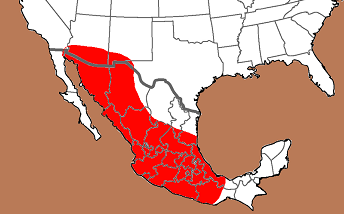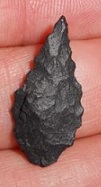Name Details:
Named By: Herbert W. Dick
Named For:
Date Identified: 1965
Type Site: Bat Cave, New Mexico
Pelona
Cluster:
Commonly Utilized Material:
Date:
Cultural Period:
5,500 - 4,000 B.P.
Middle Archaic
Early Holocene
Abejas Phase
Glacial Period:
Culture:
Phase:
Outline is Representative of Size and Shape:
Description of Physical Characteristics and Flaking Pattern:
This is a small ovoid point with an elliptical cross section. The blade is excurvate and may have serrations
from the midpoint of the blade to the tip and smooth edges from the
midpoint of the blade to the base. The shoulders, when present, are weak with a contracting stem. This type may
vary from having a contracting stem appearance to having a leaf appearance. The base is convex
and commonly thinned. This type is manufactured using
percussion flaking to form an ovoid blank then well controlled was
used on the upper half of the point to finish the blade and sharpen
the point forming a random flaking
pattern.
Size Measurements: Total Length - 23
to 60 mm (average 40 - 45 mm), Blade Width - 13 to 38 mm
(average 23 - 28 mm),
Thickness - 5 to 10 mm (average 7 mm)
Distribution:
Distribution Comments:
This point is primarily found throughout
Mexico from the Tehuacan Valley, the Valley of Mexico, Hidalgo,
Queretaro, and extends into
southern Arizona and New Mexico.

Related / Associated Points:
Additional Comments:
Pictures:


Other points in this Cluster:
Point Validity: Valid Type
Dick was a distinguished
Anthropologist and a professor at the University of New Mexico. This type was named in a professional publication and has many professional references. This is considered a valid type.
.
Age Details:
These points were found in levels IV and V in Bat Cave which provided radiocarbon dates of 5,500 - 3,000 B.P. (Justice, 2002).
References: (See Reference Page, Entry Number):
23, 30, 43, 167, 189, 190
Pelona Projectile Point, Pelona Arrowhead


